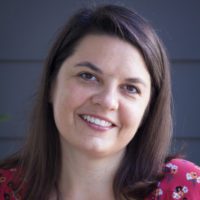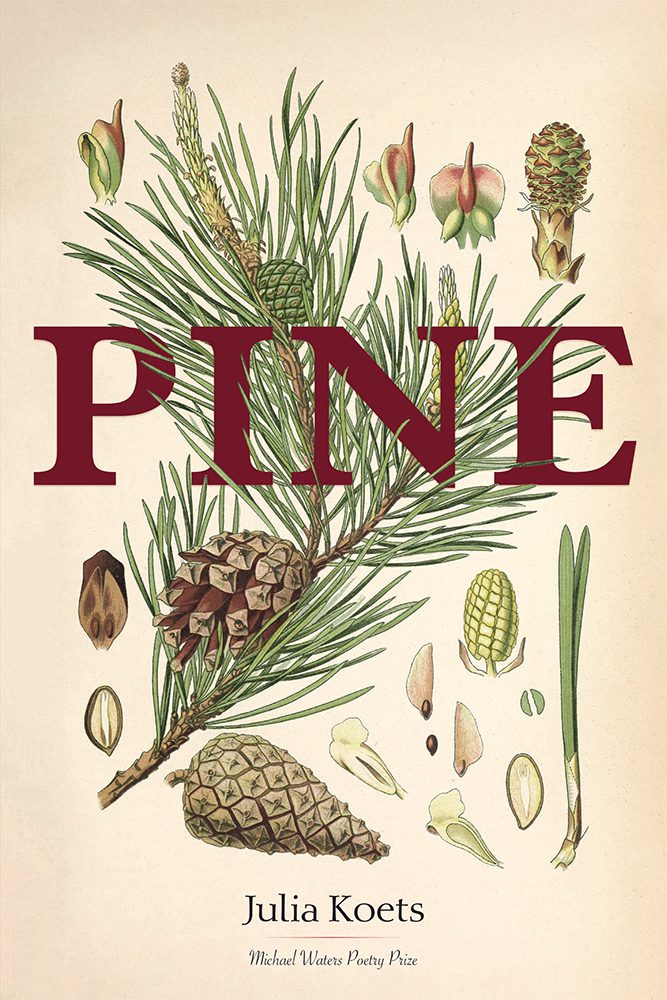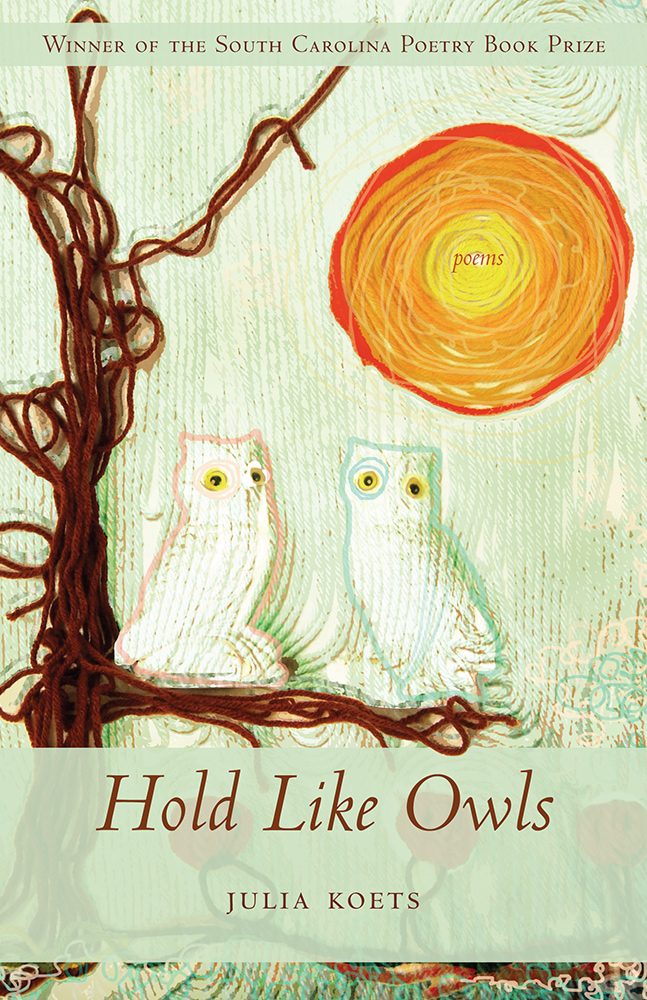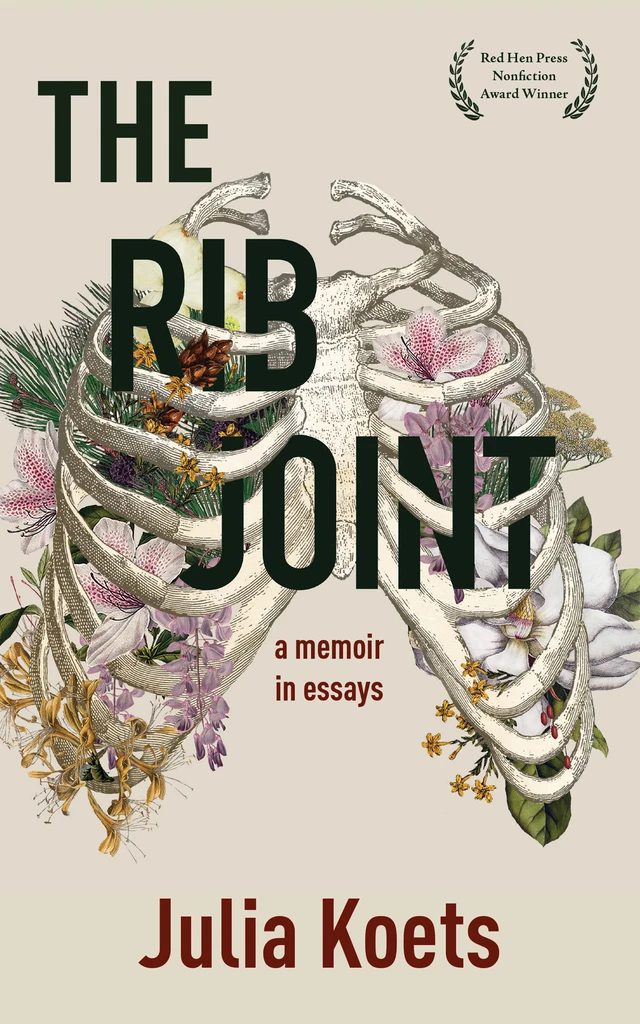I first met Julia Koets, author of The Rib Joint: A Memoir in Essays and the South Carolina Poetry Book Prize winner Hold Like Owls, at AWP in Los Angeles during the spring of 2016 when I had the pleasure of serving on a panel she organized and moderated titled “LGBTQ Memoir: Story as Survival.” I was Boy-of-My-Dreams excited to meet a fellow lesbian writer working in poetry and lyric essay, someone whose personal and literary passions ran parallel to my own.
Now, five years later, Julia and I both live and teach in Florida, and I finally had the chance to catch up with her about her prolific writing career to date. We spoke about genre-crossing, her forthcoming book PINE, and queer identity.
***
The Rumpus: In my mind, there’s a literary Venn diagram I’m often referencing and frequently updating. In one circle, I keep my touchstone poets; in the other, my touchstone creative nonfiction writers, authors of memoirs and lyric essay collections—which are sometimes one in the same. In the space where these two circles overlap is a very special group: writers who do both. Julia Koets appears there.
So, I’d like to begin by asking a question you may find very chicken-or-the-egg—and feel free to challenge the notion that there’s any primacy or hierarchy to your genre relationships at all. But I’m curious: When and how did you discover you’re a poet? When and how did you discover you’re a memoirist-qua-lyric-essayist? Do you think of yourself as more one than the other? Did one genre lead you to the other, and now you’re both?
Julia Koets: One of the first times I felt really excited about my writing was in eighth grade when I wrote a nonfiction essay for a class assignment. Our English teacher didn’t call it nonfiction, and I didn’t know the name of the genre I was writing in at the time, but that’s what it was. She asked us to draw a significant memory and then write that memory with as many specific details as we could. I drew a hike I’d taken that previous summer at an Episcopal conference center in North Carolina that my church traveled to every year. Under the drawing of the top of the mountain we reached, I hand-wrote the essay. Though no one in my life knew it at the time, I was really anxious about a crush I had on one of my friends (though I wouldn’t call it crush until many years later). I didn’t know what my feelings for her meant. Looking back, I think that the excitement I felt writing that essay was tied to the fact that the essay was the one place where I felt like I could show other people that this girl was significant to me.
In high school I started writing poems, and I loved the concision and the way the form allowed me to play with sound. I continued writing poems in college—they only offered classes in fiction and poetry at the time. In a fiction class I took, I wrote mostly nonfiction, but I never told anyone that.
I do feel a certain resistance to genre hierarchies and primacy. I think that resistance is tied to resistances I’ve felt in relationship to sexuality categories. In my early twenties, I was talking with one of my closest friends (a friend I’ve known since I was seven years old), and she couldn’t understand why I was resisting naming my sexuality as firmly fixed on one end of the spectrum. In an attempt to make me feel more comfortable assigning a particular name to my sexuality, she offered an example of the way I currently used categories: “I mean, you’d say you’re a poet, right?”
“I’d say I write poems,” I said.
Instead of one genre leading me to the other, it’s more accurate to say that I returned to nonfiction after many years of writing just poetry because of those writers you talk about in your literary Venn diagram: the writers who appear where the two circles overlap. Those writers showed me how I could do both.
Rumpus: Who are some of those writers for you? What are some of those texts? And perhaps most essential of all for readers seeking that site of overlap in their own lives—how did you find them?
Koets: During my PhD program, I studied with Danielle Deulen, and learning from someone who writes both nonfiction and poetry definitely influenced my writing, and the possibilities I saw for hybridity in my own work. At that same time, I developed two different reading lists of books I read while I was working on a memoir-in-essays and a poetry collection: queer/performativity nonfiction books and queer lyric poetry collections. It was interesting to find authors who had books in both lists: May Sarton, Mark Doty, Audre Lorde. That’s when I first read your book Wishbone, too, which is so lyrical. I was so drawn in by this scene you describe where in elementary school you dress up like a book for a play. It is in this performance as a book, “[c]loaked in those pages that you “felt the freedom to inhabit [your] body differently, to move across the stage with uncustomary confidence.” I think that’s what reading authors who write both poetry and nonfiction did for me: I felt a certain freedom about form and genre after reading those books. I continued to add to my list of writers who write both nonfiction and poetry (and still do): Lia Purpura, Jenny Boully, Kazim Ali, Saeed Jones. I also love nonfiction books that weave personal narrative, theory, and cultural criticism. Maggie Nelson’s The Argonauts, Claudia Rankine’s Don’t Let Me Be Lonely, Hanif Abdurraqib’s They Can’t Kill Us Until They Kill Us, Kevin Young’s The Grey Album.
Rumpus: For me, the discovery of those sites of overlap seemed to happen concurrently with my ability to name, at last, my own queerness. That could be a coincidence, or it could be that literary genre and sexual orientation were emerging in my understanding as points on a spectrum rather than fixed sites of being. Do you find a similar parallel or analogy between your relationship with genre and orientation? How has your relationship with naming—both naming your work and naming yourself—changed as you’ve moved deeper into your adulthood and become a published writer who, in fact, “does both”?
Koets: Yes, definitely! I was reading essays like Kazim Ali’s “Genre-Queer: Notes Against Generic Binaries” (“So perhaps the genre-defying writer is a queer one, who understands gender and genre derive from the same classifying, categorizing impulse […]”) and David Lazar’s “Queering the Essay” (“In the way that queer theory defines queer as a continuing instability in gender relations that undermines the traditional binary of gender, replacing it with indeterminate, transgressive desires. The desire of the essay is to transgress genre.”) I love to teach essays from Bending Genre, which includes both the Ali and Lazar essays.
Rumpus: I want to ask you about your two collections of poetry, Hold Like Owls and the forthcoming PINE, out on April 15 from Southern Indiana Review Press, as well as your memoir-in-essays (hybridity!), The Rib Joint. But maybe the questions that will get us there are these: What does the phrase “queer literature” mean to you? Is it different from “LGBT literature” or “lesbian literature”? I’m curious to know if this experience resonates with other writers who are also queer people, or perhaps it is an anomalous one. Do you think of yourself as a queer writer and/or a lesbian writer, and what do those monikers mean to you if/when you apply them to your work and/or when others apply them to your work?
Koets: Those are great questions. And complicated ones, I think. To me, “queer literature” as a category means that the person who wrote that piece of literature identifies as queer. That said, I think that a straight person can write a piece of writing that’s queer, in that the piece challenges genre distinctions and/or bends things in some way. I don’t think I’d teach that work in a “Queer Literature” or “LGBTQ Literature” course, though. I would teach writers who identify as LGBTQ. But, I might title a class Queering Nonfiction and talk about queerness in a broader sense.
I identify as both a queer writer and a lesbian writer. It’s hard for me to separate my identity from my writing because all aspects of my identity—as a Southerner, as a first child, as a queer person, as someone who grew up in the Episcopal Church—are a part of who I am as a writer. When someone describes me as a Southern writer, I think they’re saying that I grew up in the South, and that’s a central part of my identity. The specific plants, cadences, people, birds—all of those things that make up that place, make up me, too. When someone describes me as a queer writer or a lesbian writer, I think they’re saying that I identify as queer and/or lesbian on the sexuality spectrum.
Rumpus: Your first collection of poetry, Hold Like Owls, caught my attention because of its provocative title. At home, my partner and I use “owl” as an acronym for “older wiser lesbian”—what we hope we’re becoming with each passing year. But then there’s also this imperative to “hold” like owls, and I thought of their talons and how deliberately they hunt and how strong their grasp must be. Could you share a bit about your process writing that poetry collection and also your decision to title it Hold Like Owls?
Koets: I love that connection that you and your partner have with “owl”! When I first told my mom about the title of the book (Hold Like Owls), she went through and counted how many times versions of the word “hold” appear in the book—twenty-nine times, I think. I hadn’t consciously realized how often I’d used that word in the poems or how many times birds and winged things (like moths) appeared in the collection either. But sometimes we don’t realize our own obsessions. During the years in which I wrote the book, a lot of things went unsaid. I held certain words inside. Particularly related to questions I had about my sexuality. The poems were a place where I voiced aspects of the feelings I didn’t speak very openly about.
The title came about in a few ways. The titular poem “Hold Like Owls” is one of the last poems I wrote for the book, so that poem was on my mind when I was deciding on a title. And, admittedly, the woman who’s mentioned in that poem was also on my mind at that time, too.
I didn’t know I was writing a book of poems at the outset. I was just writing poems, and I thought about the connections after I started to put the poems into a sequence. That process involved cutting some poems that weren’t as strong and writing new poems to fill in those gaps.
I’m most proud of the fact that I didn’t edit out some of the strangeness in the images and lines. When I was looking back over the collection to answer your questions, I realized if I was editing this book now, I might smooth over some places, which I think would mean I would lose some small moments of surprise in those poems. I first started writing villanelle variations when I was writing Hold Like Owls, and during that time I learned how writing in form can lead me to connections and images I might not have found if I had been writing outside of those forms.
Rumpus: Since The Rib Joint is a memoir-in-essays, and many of the essay-chapters were published in literary journals, I’m curious as to whether you assembled this book in a manner similar to a poetry collection. I’d also like to ask what didn’t make it into this book—what essays or partial essays didn’t fit the emerging shape and style of the collection—and if that omitted work has steered you toward other projects we might hope to read in the future.
Koets: I worked with Kristen Iversen at the University of Cincinnati and took several nonfiction courses from her, and one afternoon before a reading we were both attending at the university library, she asked me when I was going to send my book out. I told her that I didn’t know if I had enough pages yet, or if the essays fit together, and she gave me some good advice. She told me to just put all of the essays into one Word document. It sounded so simple, but putting all the essays together shifted the project for me.
I wrote many of the essays in The Rib Joint before I realized I was writing a book, before I knew that the essays would appear beside one another. There was also the question of form—I didn’t know if I wanted the narratives to be structured as a memoir or an essay collection. I thought about the idea, for instance, of extending “The Rib Joint,” the titular essay, into a book, which would have been a completely different book.
When I took Kristen’s advice and put all of the essays into one Word document, I wrote the titles of the essays on a yellow legal pad, and I started adding in other essay ideas and drawing arrows to where those essays might fit into the collection. As I wrote those new essays, I would get ideas for other essays, so I added those ideas to the list, too. It was really helpful for me to have the list of titles and ideas (which became my structuring blueprint for ordering the manuscript) on a physical piece of paper. As I was reading through revisions of the individual essays, I would make notes on that yellow legal pad. When I’m writing and revising, it often takes me out of a piece if I pause for a minute and move to another Word document to make a note of something else I might write. But, if I scribble down a potential connection, scene, or idea on a sheet of paper, I don’t get distracted.
There were definitely partial essays and essay ideas that didn’t make it into The Rib Joint. I still plan to write more about church basketball, for instance. Another good piece of advice from a close friend: this book wasn’t the last book I would write about the years in my life that I write about in The Rib Joint. Not everything needed to (or should) go into that book. The process of writing The Rib Joint and publishing it helped me to understand and articulate certain things about loss, about not knowing how to name that loss for many years, and, since I discovered some of that after revising and publishing the book, my ideas about some of the experiences I talk about in The Rib Joint have expanded.
Rumpus: I’ve been reading my advanced copy of PINE. As with your memoir, I find patterns that recur in your titles—poems that begin “Eros as,” poems that are elegies, poems that are thank-you notes. There is a multivalent litany poem that explores different denotations and connotations of the word “pine,” which of course reminds me of your series of brief “Variations” essays in The Rib Joint—those close inspections of a single word like “grit.” And there is even “A Love Poem to Sally Ride” in PINE, a cultural figure whose life story serves as a touchstone for some of your own questions around passing and coming out in The Rib Joint.
This brings me to a question my students and I talk about a lot: how do you draw from the same well of content (e.g. autobiographical experience, zeitgeist and place markers from your own coming of age) and continue to innovate in such a way that the same personal history doesn’t become redundant on the page? How does moving between genres, as you do from a memoir-in-essays like The Rib Joint to a poetry collection like PINE, help you approach your content and render your stylistic inclinations (e.g. litanies, word etymologies, etc.) differently?
Koets: I drew from autobiographical experience in writing PINE, but because it’s a poetry collection and not nonfiction, I navigated that autobiographical space differently than when I write an essay or when I wrote The Rib Joint. For instance, I wrote “Eros as Oxygen Mask” about an actual experience I had. In real life, I was nineteen or twenty, and I sat on the edge of my best friend’s bed as she talked me down from a panic attack. We were sleeping together, but no one knew it at the time. In the poem, the speaker uses a paper bag to try to calm her breathing. She’s trying to understand her fear and her capacity for recognizing her fear in her body.
In real life, there was no paper bag. My best friend got me to talk, to shift my focus from the panic. It was the oxygen mask—the thing that wasn’t there in real life—that led me to write that poem, though. It was the thing that wasn’t in the memory that allowed me to remember what happened that day. In working on a different project in response to old photographs in a library archive, I was researching the oxygen masks that pilots use. While researching, I came across the EROS crew mask. I was struck by the strangeness of this utilitarian object having the same name as desire. I wondered if there were other objects and places called Eros. So, I started looking for them, and the objects I found led me to write other Eros poems.
In writing the Eros series, I drew from the same well of content that you talk about, but the form and the research for the poems allowed me to approach that content from another angle. The form and research led me to different memories, too. In “Eros as Bus” I write about a bus I took from Corfu, Greece to a ferry to Athens, and I don’t know if I would have written about that particular memory if I hadn’t researched the bus company in Spain called Eros. That’s true for other forms I wrote in in PINE, as well. One of the reasons I’m so drawn to the villanelle form, which I vary and repeat in the book, is that it’s a form that pulls us back into the past over and over. And each time we go back, we see something we hadn’t noticed before, and that noticing changes the way we see things in the present. I find that writing villanelles—particularly autobiographical villanelles—is a practice in simultaneously looking back and forward in time, which I feel when I’m writing nonfiction prose, too.
***
Photograph of Julia Koets by Eleanor Koets.







